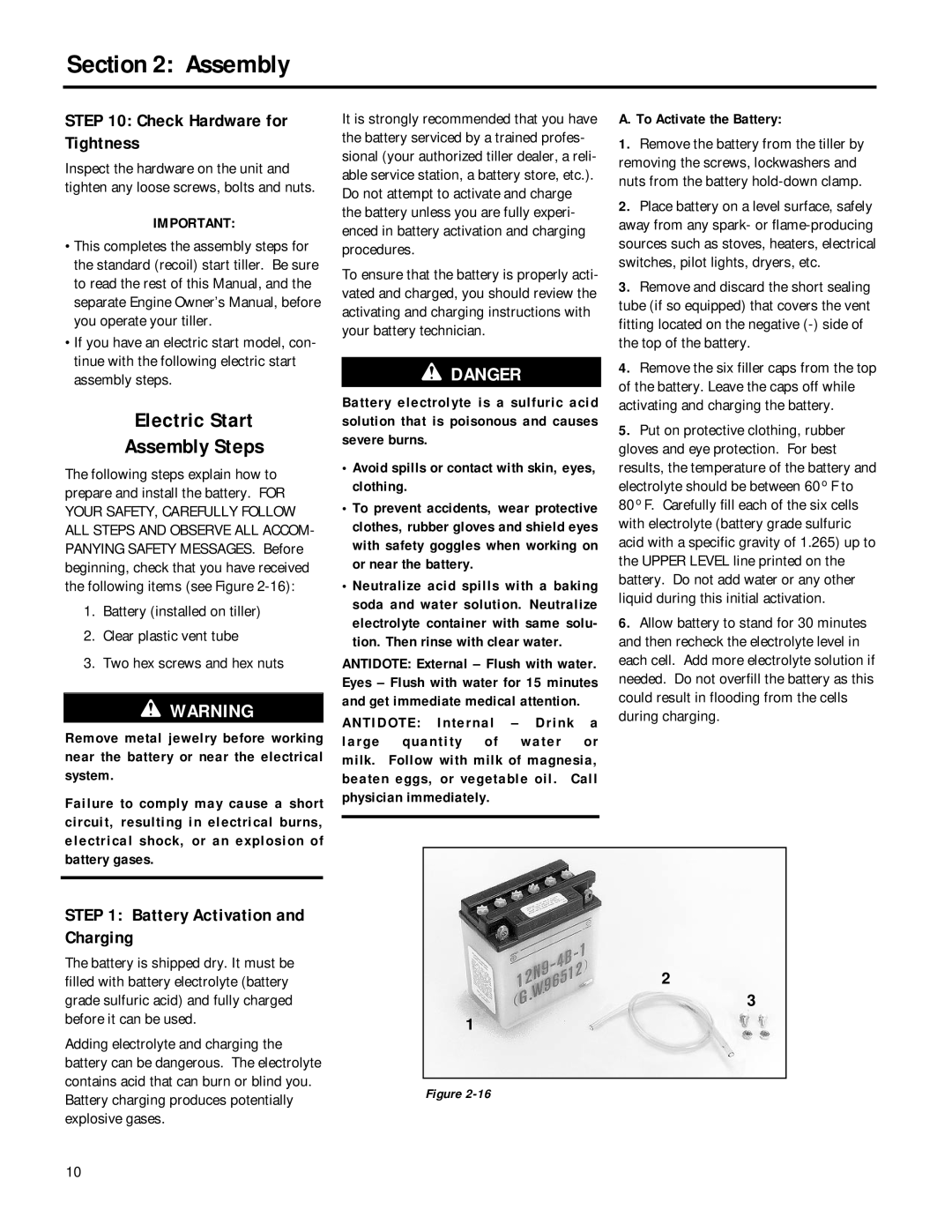
Section 2: Assembly
STEP 10: Check Hardware for Tightness
Inspect the hardware on the unit and tighten any loose screws, bolts and nuts.
IMPORTANT:
•This completes the assembly steps for the standard (recoil) start tiller. Be sure to read the rest of this Manual, and the separate Engine Owner’s Manual, before you operate your tiller.
•If you have an electric start model, con- tinue with the following electric start assembly steps.
Electric Start
Assembly Steps
The following steps explain how to prepare and install the battery. FOR YOUR SAFETY, CAREFULLY FOLLOW ALL STEPS AND OBSERVE ALL ACCOM- PANYING SAFETY MESSAGES. Before beginning, check that you have received the following items (see Figure
1.Battery (installed on tiller)
2.Clear plastic vent tube
3.Two hex screws and hex nuts
WARNING
Remove metal jewelry before working near the battery or near the electrical system.
Failure to comply may cause a short circuit, resulting in electrical burns, electrical shock, or an explosion of battery gases.
STEP 1: Battery Activation and Charging
It is strongly recommended that you have the battery serviced by a trained profes- sional (your authorized tiller dealer, a reli- able service station, a battery store, etc.). Do not attempt to activate and charge the battery unless you are fully experi- enced in battery activation and charging procedures.
To ensure that the battery is properly acti- vated and charged, you should review the activating and charging instructions with your battery technician.
DANGER
Battery electrolyte is a sulfuric acid solution that is poisonous and causes severe burns.
•Avoid spills or contact with skin, eyes, clothing.
•To prevent accidents, wear protective clothes, rubber gloves and shield eyes with safety goggles when working on or near the battery.
•Neutralize acid spills with a baking soda and water solution. Neutralize electrolyte container with same solu- tion. Then rinse with clear water.
ANTIDOTE: External – Flush with water. Eyes – Flush with water for 15 minutes and get immediate medical attention.
ANTIDOTE: Internal – Drink a large quantity of water or milk. Follow with milk of magnesia, beaten eggs, or vegetable oil. Call physician immediately.
A. To Activate the Battery:
1.Remove the battery from the tiller by removing the screws, lockwashers and nuts from the battery
2.Place battery on a level surface, safely away from any spark- or
3.Remove and discard the short sealing tube (if so equipped) that covers the vent fitting located on the negative
4.Remove the six filler caps from the top of the battery. Leave the caps off while activating and charging the battery.
5.Put on protective clothing, rubber gloves and eye protection. For best results, the temperature of the battery and electrolyte should be between 60 o F to
80o F. Carefully fill each of the six cells with electrolyte (battery grade sulfuric acid with a specific gravity of 1.265) up to the UPPER LEVEL line printed on the battery. Do not add water or any other liquid during this initial activation.
6.Allow battery to stand for 30 minutes and then recheck the electrolyte level in each cell. Add more electrolyte solution if needed. Do not overfill the battery as this could result in flooding from the cells during charging.
The battery is shipped dry. It must be filled with battery electrolyte (battery grade sulfuric acid) and fully charged before it can be used.
Adding electrolyte and charging the battery can be dangerous. The electrolyte contains acid that can burn or blind you. Battery charging produces potentially explosive gases.
2
3
1
Figure
10
